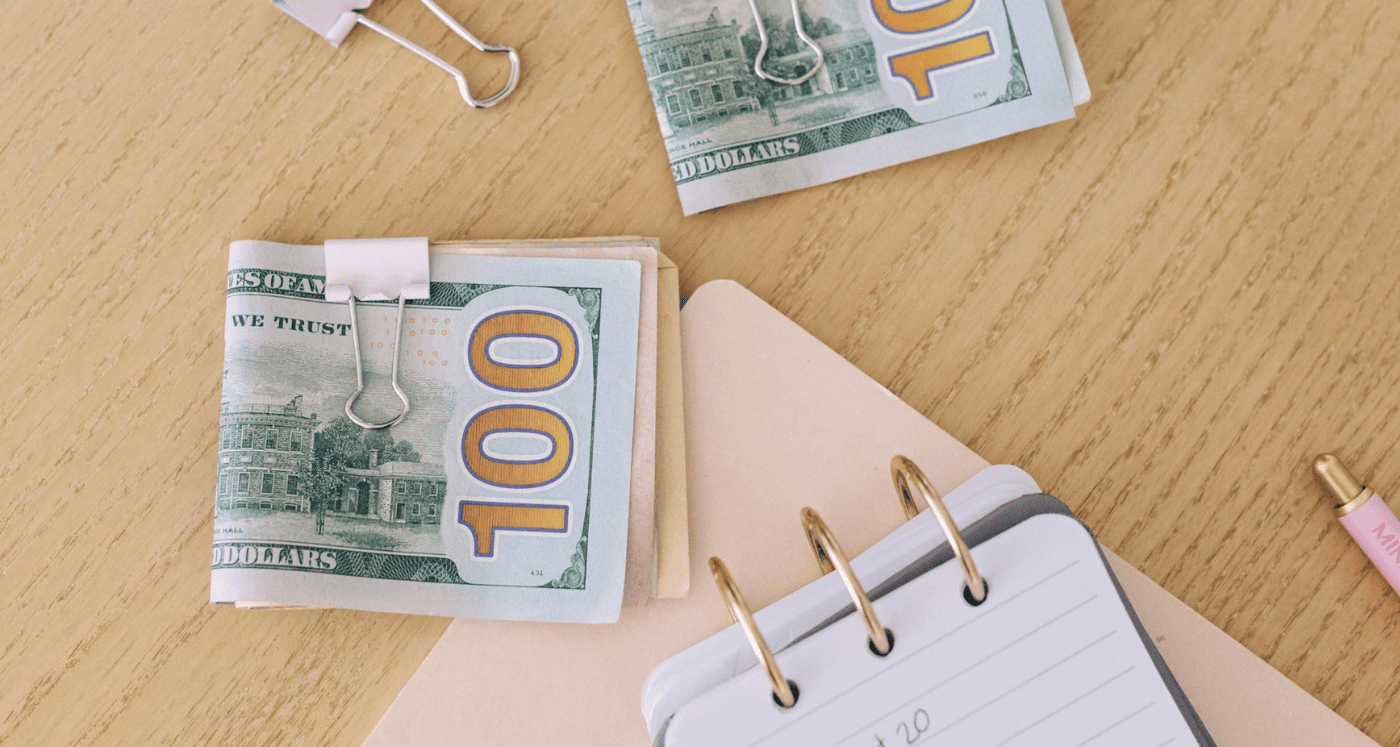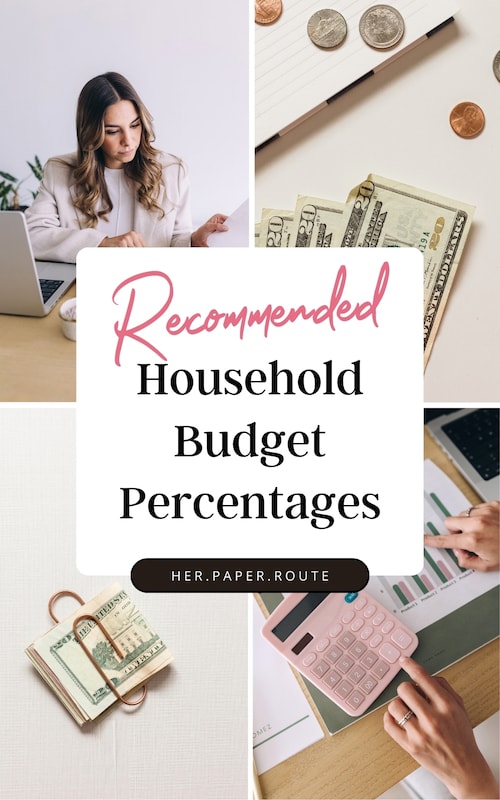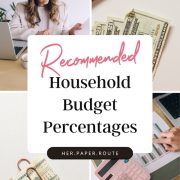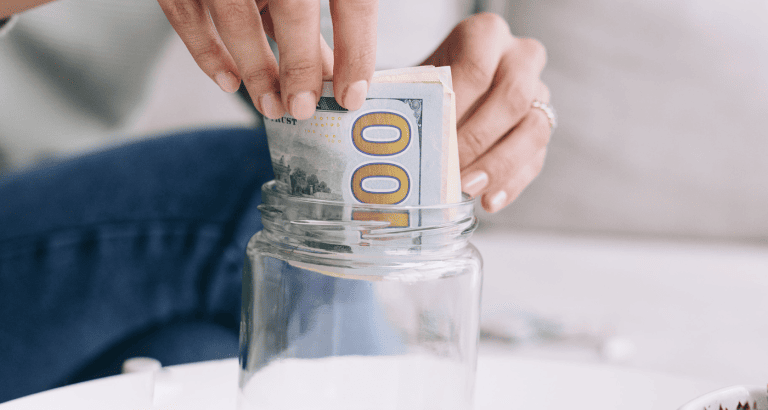Dave Ramsey Budget: Recommended Household Budgeting Percentages

If I were to ask what you spent going out to eat last month and how much you put into savings, would you be able to give a rough estimate for both?
Will you realistically be able to retire when you are hoping to with the rate you’re currently investing?
As an affiliate partner of various brands and sponsored content, HerPaperRoute may earn commission on qualifying purchases. Disclaimer
Chances are, you were unable to answer all of those questions, and if you were, the answers were more of a constant nagging reminder.
I’m not here to do that, so toss any guilt aside. Maybe you are here because you struggle with poor spending habits, have huge debts, or aren’t doing enough for retirement.
No matter what stage you are in life, it’s never too late to get started budgeting.

Learn How To Budget Your Money Like Dave Ramsey
You’ve probably heard of Dave Ramsey before, but did you know that he’s made budgeting so easy, that it’s dramatically changed many people’s lives?
Check out these Dave Ramsey budget tips below and learn what the recommended household budgeting percentages are.
Dave Ramsey’s Recommended Household Budgeting Percentages
If you are new to budgeting, or simply don’t know a good place to start, Dave Ramsey has a pretty good grasp on what you should be paying on certain expenses every month.
Keep in mind that everyone’s household budgeting percentages look a little different than others, based on their personal needs.
Here are the recommended paycheck allocations:
- Food 5–15%
- Saving or Debt Repayment 10–15%
- Housing 25%
- Utilities 5–10%
- Transportation 10%
- Clothing 2–7%
- Medical/Health 5–10%
- Charitable Gifts 10–15%
- Insurance 10–25%
- Personal 5–10%
- Recreation 5–10%

Figuring Out Your Household Allocations
You may be wondering where you should even start to figure out your household budgeting percentages? Your best option is to begin with your set expenses and go from there.
If you’re having a hard time figuring out your expenses, follow these tips for keeping track of bills and payments so that you know where all your money is going.
Your monthly home mortgage might be a little higher or lower than the recommended 25% mentioned above. This means that you’ll need to cut back, or leaves you with more flexibility with your other expenses.
Related: Here is how we save money over the course of our mortgage.
To get a better grasp of how much you need to set aside for each expense, take a look at 3-4 months of your expenses for each category. By sitting down and doing this, you now have a better idea of where your money has been going.
Several banks have apps that can already be doing this for you. There’s also the Quicken Software that also may be beneficial to you.
- Audible Audiobook
- Dave Ramsey (Author) – Dave Ramsey (Narrator)
- English (Publication Language)
- 05/14/2024 (Publication Date) – Thomas Nelson (Publisher)
Budgeting Categories Explained
Now that you know what all the categories are, you may be wondering what exactly does each one include. Below I’ll go a little more in-depth into each category.
1. Food
Your food budget is the easiest place to overspend. Dave recommends between 5-15% of your paycheck go towards food. This includes the food you buy at the grocery store AND restaurants.
My favorite way to save money at home is batch cooking freezer meals. Then with the savings, I can treat my family to a meal out.
If you find yourself eating out too often, perhaps splitting this grouping into groceries and restaurants will keep you from spending all of your budget on going out.
2. Savings
Setting money aside for savings is also extremely important. Not only does it better prepare you for retirement, but helps build your wealth, and prepares you for emergencies.
It’s best to save anywhere between 10-15% of your income, but this may look different for you depending on your situation.
3. Emergency Fund
An emergency fund falls under savings but is different than regular savings. Resorting to a credit card when an emergency comes up is usually how most people get into trouble with debt in the first place.
Dave Ramsey recommends saving up a $1,000 emergency fund even before you start paying off debt. After all debt is gone aside from your mortgage, save enough in your fund so that you can cover 3-6 months of your expenses.
This way you’re able to not fall behind if you get laid off work or are put on medical leave for whatever reason.
4. Debt Payoff
As mentioned above, you’ll want at least a $1000 mini-emergency fund before starting to pay off debt. To get out of debt the fastest, throw every additional dollar that you can towards your debt.
If you need additional motivation, these creative visuals will make debt payoff more fun for the entire family.
5. Housing
This is the category that most people who disagree with Dave, focus on. He recommends not spending any more than 25% of your income on your mortgage or rent.
Some people claim that this is unreasonable if you live in a high-cost-of-living area. The reasoning behind this number is that spending more severely restricts your ability to make progress in savings and debt paydown.
6. Utilities
Utilities should be around 5-10% of your budget. Sometimes they’re included in your rent if you’re renting.
There isn’t a lot you can do about the local cost of services but you can always try to be more energy efficient.
7. Transportation
Transportation should be no more than 10% of your budget. The lower the better.
If you find yourself with high monthly car payments on top of the costs of gas and maintenance, it could be time to trade to a less expensive car. Other options would be to carpool to work or check out public transportation.
8. Clothing
You can probably get by on the clothes you currently own. Professional work clothes are necessary to have depending on your job, but you don’t need to splurge on them.
Look for versatile basics and change up your look with less expensive accessories. Many areas even have consignment shops where you can get gently used work attire at a huge savings.
9. Medical/Health
Health insurance is a must! See if your company offers any health bonuses or exercise stipends.
Using an HSA or FSA is another way to keep your medical costs lower since those contributions are pre-tax.
10. Giving
This is listed in Dave’s percentages under charitable gifts and is one he strongly recommends. He encourages that you give 10-15% of your total net income as a donation, tithing, or used to help a good cause.
This is a healthy way of giving back and investing in people by meeting their needs.
11. Insurance
You can have a variety of insurance depending on your circumstances and needs. Some people will have term life insurance only while others need an umbrella policy and business insurance.
You can shop around yearly or every 6 months to make sure you’re still getting the best deal for the coverage you need.
12. Personal
Personal items include getting your hair cut and colored, or other necessities. With this category, you can roll any amount you didn’t use to the next month to save up for larger purchases or less frequent services.
If there are brands or products you normally use, try this hack for getting coupons from them.
12. Recreation
This is your category for fun an entertainment. Budgeting shouldn’t make you feel stressed and like you can never have fun.
A good balance between saving, getting rid of debt, and spending freely is needed in order to live a happy life. You’ll be more likely to stick to your budget by making sure you have fun with at least some of your money.
What Are Your Money Goals?
It’s also important when you are implementing a budget, to figure out what your goals are. This will help you to come up with a plan to reach your goals.
Maybe you’re trying to get out of debt, pay off school loans, or could really use a family vacation?
By having goals, you’ll be less at risk of spending money in places that you don’t need to be spending and putting every dollar to good use. This keeps you from accumulating any more unnecessary debt.
Types of Budgeting Methods
There are a number of methods out there that you could use for budgeting. It’s really a matter of what works best for you and that you are willing to stick with it. Let’s take a look at a few of them.
The Cash Envelope System
The cash envelope system was made popular by Dave Ramsey, where this type of budgeting involves spending money while using cash only.
Just like the name suggests, you’ll have several envelopes that are separated by a different budgeting category. Each envelope has the equivalent to pay each expense when they are due each month.
✅ You can print your own envelopes out right now from my store!
If you need an easy way to carry around all your cash envelopes, check out my review of the best cash envelope wallets.
Line Item Budgeting
This is the traditional way of doing your budgeting, where you will categorize all your spending in a spreadsheet. It involves more detail but is often viewed as more a tedious method.
The 50/30/20 Method for Budgeting
This type of budgeting is pretty straightforward. The first 50% after taxes of your income should go towards your needs. 30% can go towards your wants, while 20% is recommended that you put back for savings or paying off debt.
Zero-Based Budget
With the zero-based budget, it means that your income minus expenses equals zero.
This doesn’t mean that you have zero dollars left over in the bank at the end of each month, but that every dollar is being put towards an expense or is being saved. This budget is based on your prior month’s expenses.
Final Budgeting Tips
If you’ve struggled with credit cards or out-of-control spending in the past, here’s something to keep in mind.
For starters, leave the credit card at home and use cash only for your groceries and other purchases. By only having cash as an option, you’ll be much more careful and conscious of how much you spend your money.
Eating expenses can get out of control in a hurry. Try cutting back on how many times you stop for a cup of coffee or stop in at a drive-thru each week. While it may be more convenient, choosing to eat at home or making a pot of your own coffee can save you so much more.
Maybe your family needs to be more careful with the money that is being spent on entertainment each month?
A budget is not to make your lives miserable, but so that you are more aware of how and where you could be better placing your money. There are several free activities like hiking or going on a picnic that your family could do instead.
Not everyone always agrees on certain methods or how every detail is presented in the Dave Ramsey budget, and that’s okay.
You don’t have to agree with everything that he says, but it’s hard to argue against a majority of his advice when it’s helped so many people. What is important, is that you find what works for you and stick with your household budgeting percentages that you’ve come up with.
Related Articles
- Get Your Finances In Order With The Extreme Budgeting Binder
- Best Budget Planners & Notebooks Reviewed
- Dave Ramsey Baby Steps: Everything You Need to Know

Follow along on Instagram!











